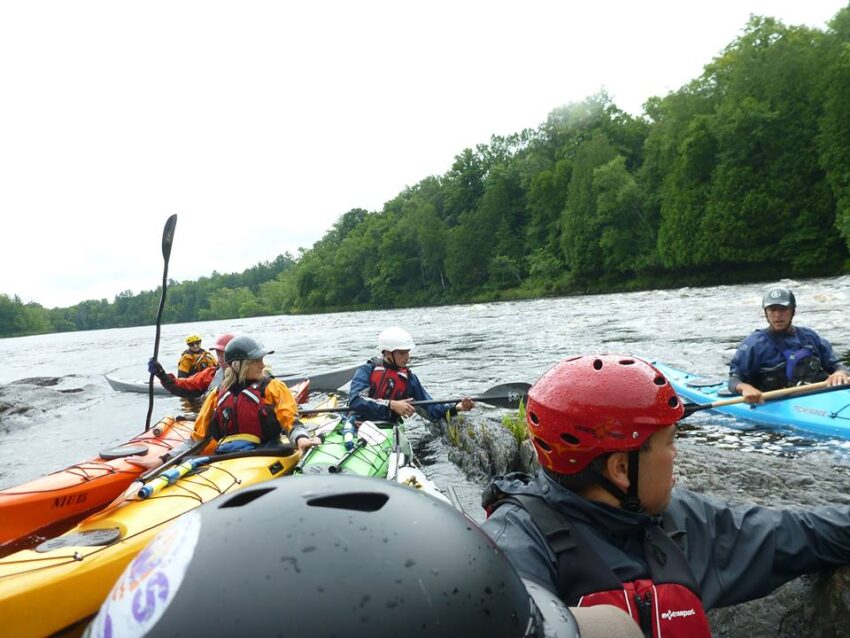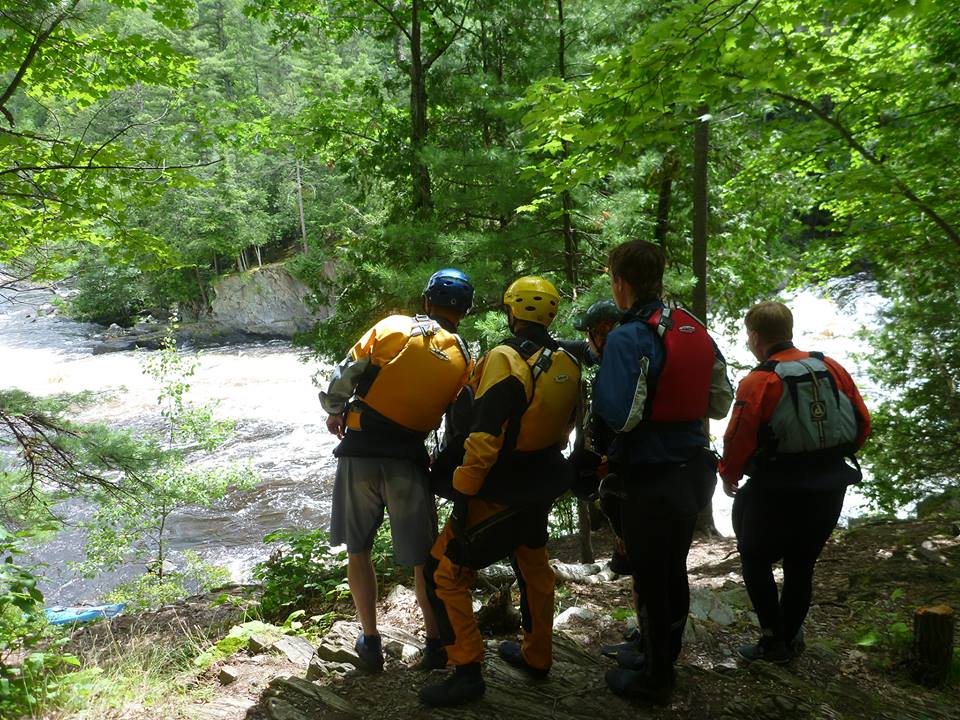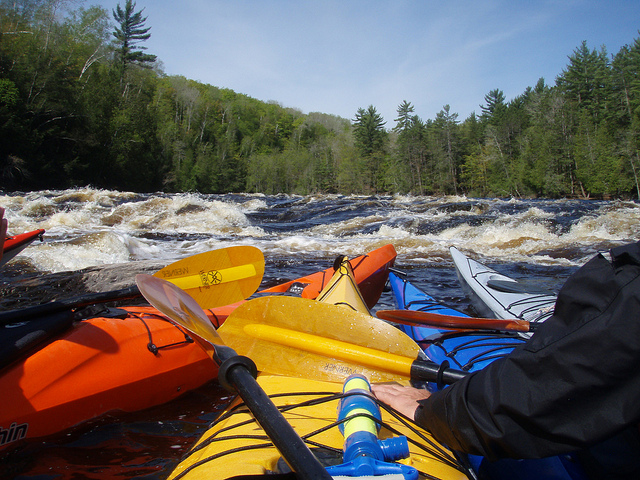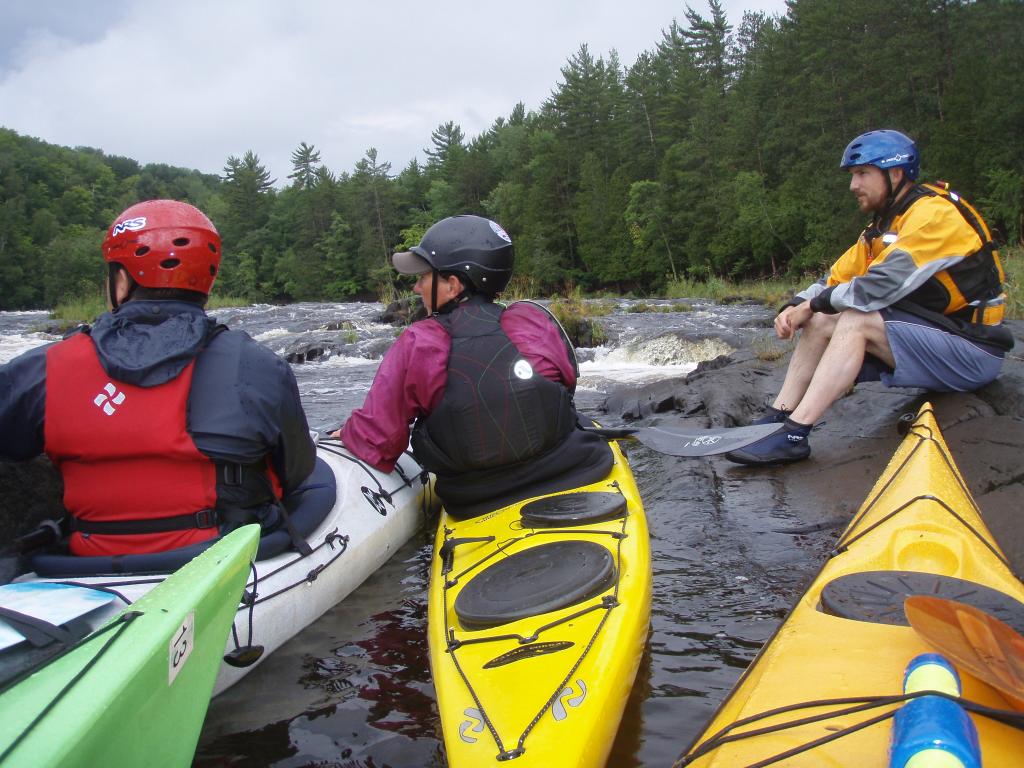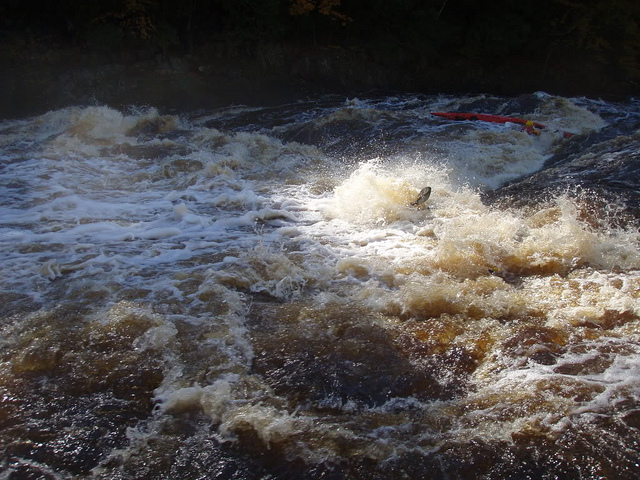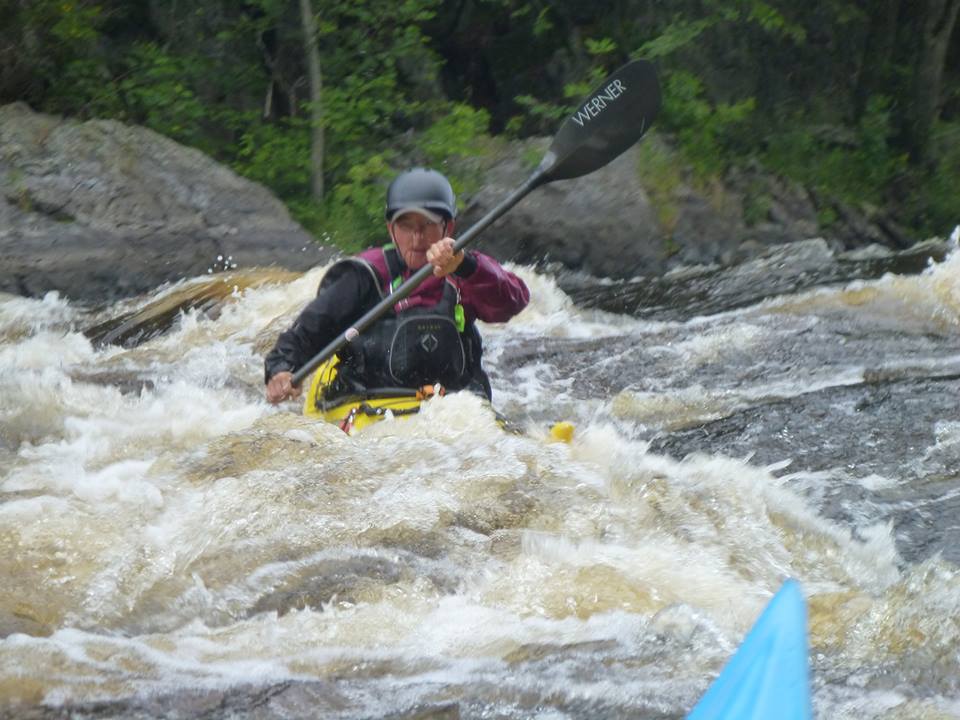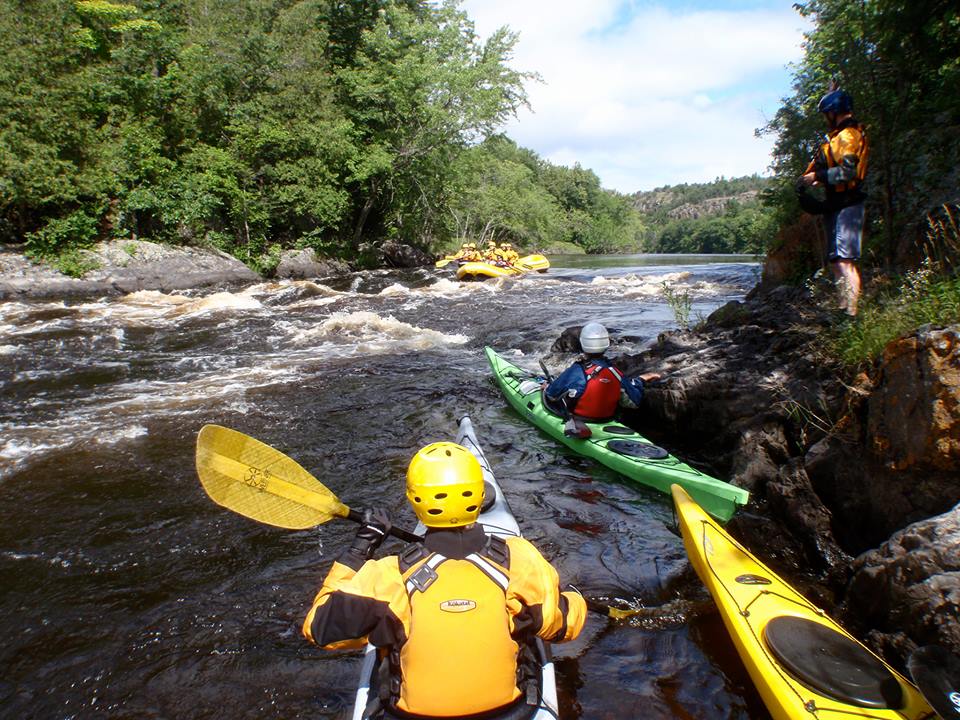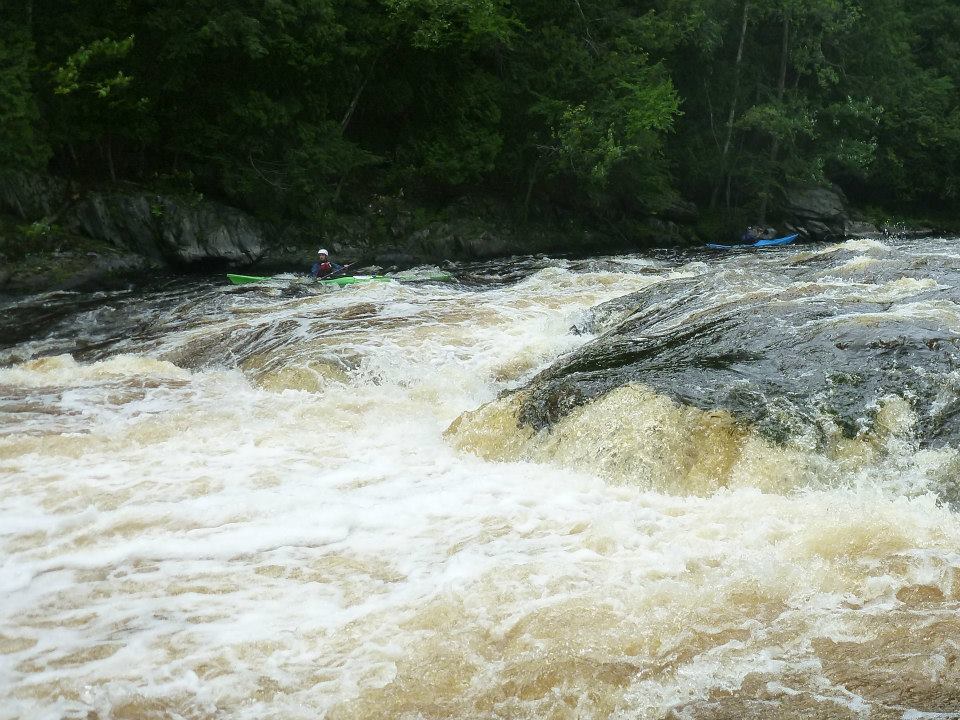By Mary Fairchild
Sara Hartman, Ron Laird, Mary Fairchild, Alex Reily, Walter Afable, and Ryan Rushton; Terminal Surfer; July 26, 2013; 1800 CFS. Picture courtesy: Kat Kulchinski.
Intentional hole and wave surfing are the bulk of what river runners call play. It means stopping at a river feature and exploring what it has to offer. Play takes all of the skill needed to run down the rapid and applies it to the energy the river exerts on one spot. Play is a great way to build on the basic skills of river running.
Holes are a frequent feature of white-water rivers and most kayakers avoid them, but some attract playboaters. Holes exist where a strong current pours over a ridge of rock. Terms like “stopper, keeper, sticky, terminal” are used to describe a hole due to its plunging cycle of the water tumbling and falling back on itself. Some people call them hydraulics and other’s call them a washing machine. Keeper holes stick boats and keep them in a cyclical flow and holes on high volume flows tend to be more trouble than holes in low flows.
Chris Martin, Sarah Hartman, Kat Kulchinski, Alex Riley, and Ron Laird. Picture courtesy–Kat Kulchinski.
It’s important to scout out unfamiliar flows even on rivers you feel comfortable with. The first thing I noticed when I hiked up the trail on the Menominee River last week was how quiet the river sounded this time. The past two dates I paddled Piers Gorge, in the fall of 2010 and more recently May 26th, the river was running over 3000 CFS and there were a lot of swims (Along the Way Blogspot).
“The water had been around 1000 CFS when I’d been there in early June; now it was around 3000 CFS (based on USGS info)…On Friday, we spent the day at “Terminal Surfer”, if I got the name right. We were at the bottom end of the rapids and worked on the eddy lines. In June we had few or no capsizes; this time they were pretty regular. We learned to be much more aggressive at getting to capsized boats for rescues, and how to roll in the bumpy water (interesting to find your set up position when the surface is uneven and constantly moving.) Having the swimmer flip their boat and move to the bow was a big help in getting our rescue times down.” Peggy Oneal
The ability to flip over and get back up without swimming is considered an essential safety skill for Class III or harder whitewater.
Chris Martin, Mary Fairchild, Jeff Fudala, and Sarah Hartman. May, 2013, at Terminal Surfer; 4400 CFS.
The release from the Little Quinnesec Falls Dam determines water levels and the dam does not operate on a set schedule. The river levels fluctuate and when they reach above 3000 CFS the drop at Missicot Falls and many of the holes below it present powerful hydraulics.
Two specific features tend to form strong holes–pourovers and ledges. Pourovers are rocks with water pouring over their tops and ledges are long low abrupt drops in the river bed. Both of these are common river features with the potential to form strong hydraulics.
Walter Afable, Kat Kulchinski, and Chris Martin; July 26th at Terminal Surfer just under 2000 CFS.
I had noticed that it seemed like the second eddy we would enter was too close to the hole. Then, after a few S-turns I found myself getting very close to the hole and I let my bow slowly on it. That was the highlight of my day. I didn’t know I could do it. I started surfing it. I was amazed how tightly it held my bow as I balanced and toyed with it.
Amazingly, I had entered on the correct side. American Whitewater recommends that you surf Terminal Surfer on the surfers right side and that the surfers left side of the hole is quite trashy and has “stripped many boaters of their pride and scared the crap out of them also.”
After a few minutes I was able to slip off with a draw to the side. At the end of our day Alex chose to paddle over the hole with success. He knew from his whitewater paddling to speed up to get over it and with the lower river levels he had no problem. A few years ago, I paused when I saw it and just slid right in not knowing what to do. The river was running much faster that day as well–around 3000 CFS.
If you go down the ramp like I did, your kayak will go under the foam pile, where all the water is flowing downstream and you will be hit in the chest and face by a powerful current flowing back upstream, but if you paddle hard, like Alex did last Friday and lean forward to reduce the impact you can get through.
When you get stuck it’s called a stopper. If you try to punch through a stopper and don’t make it, after a second or so the water will turn you sideways and you will capsize unless you can raise the upstream edge of your kayak, and you do a low brace on the downstream side. Getting out of a small hole is easy, just paddle forwards or backwards.(3)
We came from various backgrounds and experience due to age, timing, and life in general. Several of us had previous whitewater experience, some more than others, some of us were certified in various levels of ACA or BCU. Sarah Hartman and I looked at the great experience that young paddlers like Alex, at the age of 18, can get and briefly wondered why we hadn’t thought of kayaking sooner. Walter Afable and I discussed how our children, my 4–who are now young adults, keep us busy and unable to kayak regularly.
Missicot Falls 2011;around 3000 CFS.
In the afternoon of our first day, after being patient and waiting out a brief period of thunder and lightening, our group began to practice ferrying and crossing eddies from one side of the river to the other just a short distance up the river. About half way across the river there was an overpour that marked the place where we could attain and move further up the river to play with new features. The hard part was to steer clear of the current that flowed down the sides of the overpour, especially the left side because it had a tendency to send you into a strong wave train backwards very quickly.
First Alex made his way up and over and then after a few attempts Chris was over. After a few tries I was resting in the eddy nearby with Kat when we saw Sarah attempting to assist Walter with a rescue when, all of a sudden, they were carried swiftly down a wave train and on towards the Terminal Surfer hole. Kat and I whistled and signaled to Ryan who was up with Alex and Chris by the noisy falls. Fortunately, they did hear the whistle after quite a few blows and I had my paddle up to get their attention to come to me, as we had planned for emergencies. This part of the river was the perfect place to practice rescues, both self and assisted because the current and features where strong enough to challenge us but yet very safe.
Kat ferrying across to her eddy at Sand Portage Falls. Picture courtesy: Kat Kulchinski.
When paddlers become comfortable with entering and exiting eddies, they can start to use them to run rapids more efficiently. The simplest rapids require a paddler to stay in the main channel lined up for the “V”, more demanding rapids may require using eddies to avoid obstacles or just slow things down a bit. Whatever the paddler can do to break down the rapids into individual moves will help the paddle to be more safe and efficient.
Sand Portage Falls eddy: CFS below 2000. Sarah Hartman, Alex Riley, Chris Martin. Picture courtesy: Ron Laird.
Multiple-boat eddies that are next to play spots are where a rough line of paddlers can form to wait to ride a wave or hole or wait for the commercial raft traffic to pass.
Missicot Falls: Alex Riley followed by Ryan Rushton. Picture courtesy–Kat Kulchinski.
Longboats in Current is a great way to improve sea kayak handling in currents which will transfer to paddling in tide rips, races and overfalls along the coast. The Menominee River provides a safe and fun learning environment in high volume Class II-III whitewater.
References
- Hunt Fish Camp Wisconsin, “Canoeing the Menominee River, Wisconsin.”
- Great Lakes Waterfalls and Beyond, “Piers Gorge.”
- Kayarchy, “Paddling Your Sea Kayak: Advanced Sea Kayaking—Fast Moving Water and Surf.”
- Topkayaker.Net: ”Moving Water Technique,” Henry E. Dorfman.

